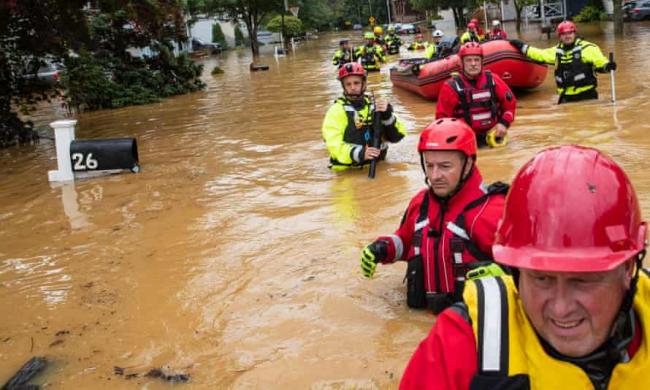Articles Menu

If there’s one thing we know about climate breakdown, it’s that it will not be linear, smooth or gradual. Just as one continental plate might push beneath another in sudden fits and starts, causing periodic earthquakes and tsunamis, our atmospheric systems will absorb the stress for a while, then suddenly shift. Yet, everywhere, the programmes designed to avert it are linear, smooth and gradual.
Current plans to avoid catastrophe would work in a simple system like a washbasin, in which you can close the tap until the inflow is less than the outflow. But they are less likely to work in complex systems, such as the atmosphere, oceans and biosphere. Complex systems seek equilibrium. When they are pushed too far out of one equilibrium state, they can flip suddenly into another. A common property of complex systems is that it’s much easier to push them past a tipping point than to push them back. Once a transition has happened, it cannot realistically be reversed.
The old assumption that the Earth’s tipping points are a long way off is beginning to look unsafe. A recent paper warns that the Atlantic meridional overturning circulation – the system that distributes heat around the world and drives the Gulf Stream – may now be “close to a critical transition”. This circulation has flipped between “on” and “off” states several times in prehistory, plunging northern Europe and eastern North America into unbearable cold, heating the tropics, disrupting monsoons.
Other systems could also be approaching their thresholds: the West and East Antarctic ice sheets, the Amazon rainforest, and the Arctic tundra and boreal forests, which are rapidly losing the carbon they store, driving a spiral of further heating. Earth systems don’t stay in their boxes. If one flips into a different state, it could trigger the flipping of others. Sudden changes of state might be possible with just 1.5C or 2C of global heating.
A common sign that complex systems are approaching tipping points is rising volatility: they start to flicker. The extreme weather in 2021 – the heat domes, droughts, fires, floods and cyclones – is, frankly, terrifying. If Earth systems tip as a result of global heating, there will be little difference between taking inadequate action and taking no action at all. A miss is as good as a mile.
So the target that much of the world is now adopting for climate action – net zero by 2050 – begins to look neither rational nor safe. It’s true that our only hope of avoiding catastrophic climate breakdown is some variety of net zero. What this means is that greenhouse gases are reduced through a combination of decarbonising the economy and drawing down carbon dioxide that’s already in the atmosphere. It’s too late to hit the temperature targets in the Paris agreement without doing both. But there are two issues: speed and integrity. Many of the promises seem designed to be broken.
At its worst, net zero by 2050 is a device for shunting responsibility across both time and space. Those in power today seek to pass their liabilities to those in power tomorrow. Every industry seeks to pass the buck to another industry. Who is this magical someone else who will suck up their greenhouse gases?
Their plans rely on either technology or nature to absorb the carbon dioxide they want to keep producing. The technologies consist of carbon capture and storage (catching the carbon emissions from power stations and cement plants then burying them in geological strata), or direct air capture (sucking carbon dioxide out of the air and burying that too). But their large-scale use is described by the Intergovernmental Panel on Climate Change as “subject to multiple feasibility and sustainability constraints”. They are unlikely to be deployed at scale in the future for the same reason that they’re not being deployed at scale today, despite 20 years of talk: technical and logistical barriers. Never mind: you can keep smoking, because one day they’ll find a cure for cancer.
So what’s left is nature: the capacity of the world’s living systems to absorb the gases we produce. As a report by ActionAid points out, there’s not enough land in the world to meet the promises to offset emissions that companies and governments have already made. Even those who own land want someone else to deal with their gases: in the UK, the National Farmers’ Union is aiming for net zero. But net zero commitments by other sectors work only if farmland goes sharply net negative. That means an end to livestock farming and the restoration of forests, peat bogs and other natural carbon sinks. Instead, a mythical other will also have to suck up emissions from farming: possibly landowners on Venus or Mars.
Even when all the promised technofixes and offsets are counted, current policies commit us to a calamitous 2.9C of global heating. To risk irreversible change by proceeding at such a leisurely pace, to rely on undelivered technologies and nonexistent capacities: this is a formula for catastrophe.
If Earth systems cross critical thresholds, everything we did and everything we were – the learning, the wisdom, the stories, the art, the politics, the love, the hate, the anger and the hope – will be reduced to stratigraphy. It’s not a smooth and linear transition we need. It’s a crash course.
[Top photo: A flash flood caused by Tropical Storm Henri in Helmetta, New Jersey, on 22 August 2021. ‘The extreme weather in 2021 – the heat domes, droughts, fires, floods and cyclones – is, frankly, terrifying.’ Photograph: Tom Brenner/AFP/Getty Images]